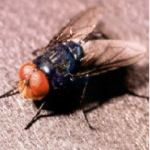The New World screw-worm fly (Cochliomyia hominivorax), screw-worm for short, is a species of parasitic fly that is well known for the way in which its larvae or maggots eat the living tissue of warm blooded animals. It is present in the New World tropics. Screwworms are the larvae (maggots) of a certain fly species that feed on living tissue of animals. Although these flies have been eradicated from the United States, Mexico and Central America, they can still be found in some countries of South America, the Caribbean, Southeast Asia, India and Africa. Infestation of a live warm blooded animal by a maggot is technically called myasis. While the maggots of many fly species eat dead flesh, screw-worm maggots are unusual because they attack healthy tissue.
Life cycle
Screw-worm females lay 250-500 eggs in the exposed flesh of a superficial wound of warm-blooded animals, including humans and birds. Most cases occur in cattle, goats and sheep. Screwworms can infest a wide variety of wounds (e.g. tick bites, wire cuts and other injuries). Navels of newborn mammals are a common site for screwworm infestation. The larvae hatch and burrow into the surrounding tissue as they feed. If the wound is disturbed during this time the larvae burrow or “screw” deeper into the flesh, which is the source of the insect’s name. The maggots are capable of causing severe tissue damage or even death to the host. Approximately three to seven days after hatching the larvae fall to the ground to pupate The pupae reach the adult stage about seven days later. Female screw-worm flies mate four to five days after hatching. The entire life cycle is approximately twenty days. A female can lay up to 3,000 eggs and fly up to 200 km (125 miles) during her life.
Control
The Unites States officially eradicated the screw-worm in 1982 using the sterile insect technique. This is when not fertile males are introduced in the population. When these males mate with females they will not produce fertile eggs, thus making the population smaller. The screw-worm was eradicated in Guatemala and Belize, but also previously in Curacao and Aruba. The last infection in Aruba in 2004 lasted approximately 8 months. Eradicating the epidemic was accomplished by using the sterile insect technique.
A few questions to ask yourself:
What animals get screwworm?
Screwworms can infest all warm blooded animals, including birds. Most cases occur in cattle, goats and sheep.
The screwworm eggs lay in the wound hatch into larval screwworm, which feed on the living tissue of the animal. Screwworm infestations are difficult to detect at first. Slight movement might be seen inside a wound, but the larvae feed and the wound gradually enlarges and deepens.
Can I get screwworm?
Yes. Humans can get screwworm (vector) in the same manner as animals
– by flies depositing larvae on an open wound.
Who should I contact, if I suspect screwworm?
In Animals – Contact your veterinarian immediately.
In Humans – Contact your physician immediately.
How can I protect my animals from screwworm?
Animals must be carefully examined by their owner. In cases of suspicion they must be taken to a veterinarian for careful examination. Wounds should be closely checked for any screwworm eggs or larvae that could be there. Observe your animal for signs or the presence of screwworms. Screwworm eggs are creamy and white and deposited in a shingle-like manner on or near the edges of superficial wounds. The larvae are cylindrical with one pointed end and one blunt end and have rings of dark brown spines around the body. Female screwworm flies are larger than a housefly with a dark blue to blue-green body and reddish-orange head.
How can I protect myself from screwworm?
While traveling in countries that have screwworms, pay careful attention to any wounds to help protect yourself from screwworm infestation.
- Larvae (maggots)
- Parasitic fly



